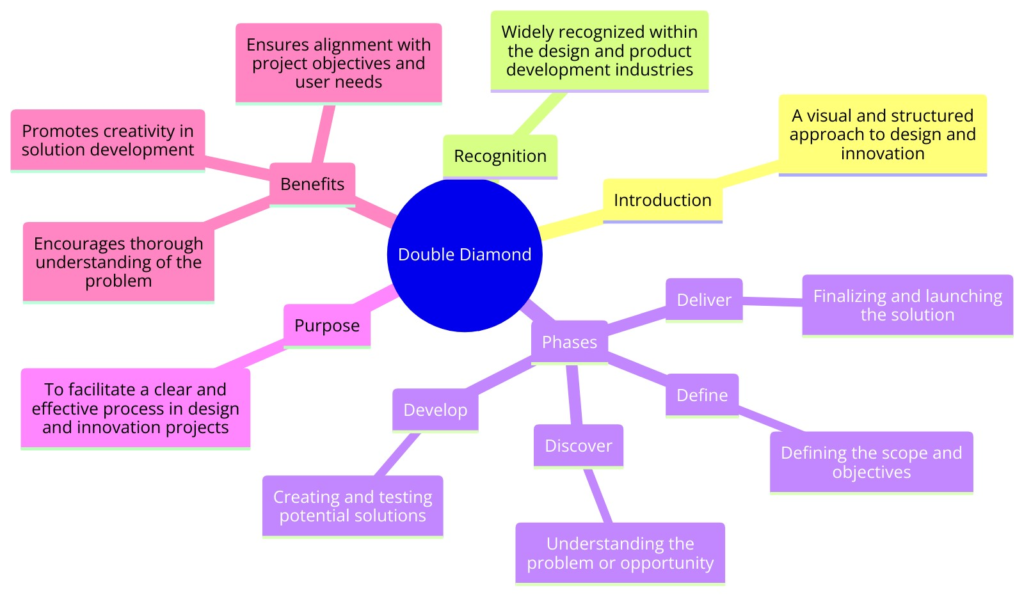Double Diamond Model
The Double Diamond is a visual and structured approach to design and innovation, widely recognized within the design and product development industries. Developed by the British Design Council in 2005, this model has become a cornerstone in understanding and applying the design process, particularly in the fields of product design, service design, and user experience (UX) design. The Double Diamond emphasizes the iterative nature of the design process, focusing on expanding and converging phases of thought and action to solve problems and innovate effectively.
What is the Double Diamond?
The Double Diamond model is comprised of four distinct phases, divided into two main sections: the first diamond focuses on understanding and defining the problem, while the second diamond emphasizes developing and delivering the solution. The four phases are Discover, Define, Develop, and Deliver. This structure advocates for a balanced approach between creative thinking (diverging) and critical thinking (converging), ensuring that design efforts are both innovative and focused.
Origin of the Framework
The Double Diamond model was developed and popularized by the British Design Council as part of their efforts to provide a simple visual representation of the design process. This was in response to the need for organizations to integrate design thinking as a strategic tool for innovation. The model was inspired by observations of the design practices across various industries and aimed to capture the commonalities in the creative process in a way that is accessible and actionable.
How It Works
- Discover: This initial phase is about research and exploration. Designers and teams explore the problem space broadly without committing to a specific direction. Activities in this phase might include user research, market analysis, and stakeholder interviews to gather a wide array of insights.
- Define: The second phase focuses on synthesizing the insights gained during the Discover phase to clearly define the actual problem to be solved. It’s about converging on a clear understanding and setting the scope and objectives for the project.
- Develop: After defining the problem, the Development phase involves exploring possible solutions through brainstorming, prototyping, and iterative testing. This phase is characterized by a wide exploration of solutions, encouraging creativity and innovation.
- Deliver: The final phase converges on the delivery of a solution. It involves refining prototypes, finalizing designs, and implementing the solution. This phase also includes assessing the impact and effectiveness of the solution in solving the defined problem.
Why It Is Valuable
The Double Diamond model offers several benefits:
- Structured Creativity: Provides a structured yet flexible framework that balances creative exploration with focused decision-making.
- Problem Solving: Ensures that the problem is thoroughly understood and defined before attempting to develop solutions, leading to more effective and user-centered outcomes.
- Collaboration: Facilitates collaboration among cross-functional teams, as it clearly delineates phases where input and consensus are crucial.
- Adaptability: Can be applied to a wide range of problems, from product and service design to digital experiences and beyond.
When and How to Use It
The Double Diamond is applicable in various contexts where solving complex problems is required, including:
- New product development
- Service innovation
- User experience and interface design
- Organizational change and strategy
To use the Double Diamond effectively:
- Clearly differentiate between the four phases, ensuring that time is allocated for both divergent and convergent thinking.
- Engage relevant stakeholders and users throughout the process to gather diverse insights and validate solutions.
- Iterate within and between phases based on feedback and new insights.
Shortcomings/Criticisms
Despite its popularity, the Double Diamond model has faced some criticisms:
- Over-Simplification: Some argue that it oversimplifies the design process, which can be more nonlinear and chaotic than the model suggests.
- Implementation Challenges: Without a strong understanding of the model and disciplined application, teams can struggle to apply it effectively in real-world projects.
- Risk of Rigidity: There’s a risk that the structured nature of the model might stifle creativity if applied too rigidly.
The Double Diamond offers a valuable framework for navigating the complexity of design and innovation projects. Structured processes into distinct phases of exploration and refinement provide a clear methodology for developing solutions that are both creative and effective. However, its successful application requires flexibility, iteration, and a deep understanding of the nuances of design thinking.


